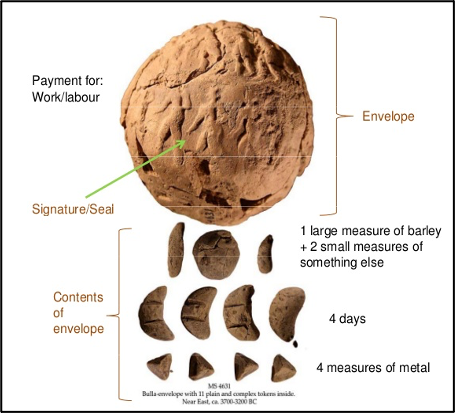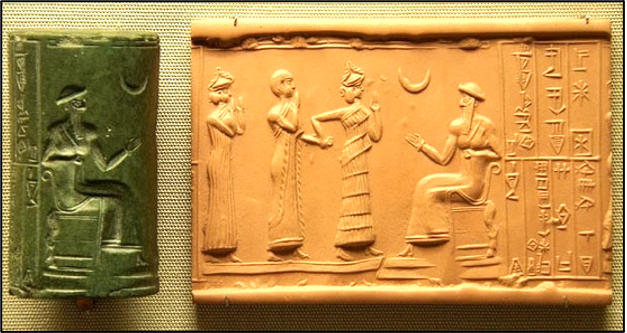Stephanie Guerin-Yodice

Another technological innovation unique to the people of Mesopotamia is written communications. The importance of irrigation and access to waterways highlighted in the case study on the kings of Lagash and Umma demonstrates how important communication and documentation was to the ancient Sumerians. It makes sense then, that this region is also responsible for originating communication through shapes, signs, symbols, and eventually, letters. The earliest evidence of written communication, called cuneiform, dates back to 7500 BCE and was found in the form of tokens or seals that served as legal documents, identification, or a form of recordkeeping. These small forms of oddly shaped clay were originally a way to record agricultural and pastoral exchanges that were traded, stored, or sold.[1] Together, the shape of the token and the stylized markings on it convey a pictorial resemblance to the physical object. Much like we use wallets and change purses today, the tokens were stored in larger hollowed-out balls of clay called bulla, which held the items in an “envelope” to represent a sealed contract. Subsequently, trade routes expanded beyond the Sumerian region and there was need for more complex forms of communication. The technological process of the written word advanced toward cuneiform. Cuneiform combines word-concepts (pictograms) with phonics to create monosyllabic words that represent the image and action being described.
The small cylinder seal in Figure 11 dates back to 5000 BCE and represents another form of written communication that is specific to the Mesopotamian region. Fashioned primarily out of stone, these seals became popular because they could be easily carried on a rope or pinned to a garment, making them less cumbersome then the bulla or stone tablets. Made from local stone such as hematite, lapis lazuli, and even obsidian, the objects were made by a burgul or sealcutter who carved a small cylinder from the stone and drilled a hole lengthwise through the middle.[2] Images were carved on the stone so that when it was rolled across wet clay an impression of the writing or design was created.
Cylinder seals were commonly used by anyone involved in business dealings, but they served a more extensive purpose than just recordkeeping. The seals usually bore an individual’s identification and occupation. When the seal was rolled on to a wet clay surface, its image served as a calling card or signature for proof of payment, much like a business card or signature on a credit-card receipt is used today. In addition to personal rank and standing, cylinder seals held decorative motifs that reflected the style and culture of Mesopotamia. Each seal was fashioned out of locally quarried stone with designs that were indicative of the region and the period in which it was created. As a result, archeologists and historians utilize cylinder seals to learn more about the daily lives of people who lived throughout the ancient Mesopotamian region. The images tell of everything from epic tales, religious rituals, objects found in nature, and everyday domestic life to administrative hierarchies, making them both functional and culturally reflective.
As the written word evolved into an alphabetic language, the use of clay tablets remained the primary form of documentation through the Mesopotamian region, and was used for literature, administration, commemoration, recordkeeping, and business transactions. It was not until the time of the Phoenicians, residents of a coastal city-state in the Levant region that monopolized maritime trade across the Mediterranean Sea, that a more simplified alphabetic language replaced the Sumerian alphabet. The Phoenician alphabet, made up of a combination of Egyptian hieroglyphics and cuneiform, spread as the city-state engaged in maritime trade throughout the region.
For example, in looking at fig. 12, the first image is a pictograph of an object that is used to represent the generic term for grain (translated into bread). By 3200 BCE, different types of grain, such as wheat, oats, and barley needed specialized identification called ideogram, which can be seen in the second image.
While the pictogram and ideogram for barley is easily identifiable in the first two images, by 3000 BCE the image for barley becomes more stylized as techniques in writing advanced toward signs for syllables and vowels called logographic. Not only is the image of barley more stylized but it is turned on its side and depicts not just a singular “grain” but the amount of barley per volume. Moving to the last and final image of barley, the written word became more complex as it transitioned to include both barley on a Cuneiform table that represents a transaction or record but the sound for barley, called a logograph. The last image represents the transitions from the of barley into a phonogram and phonetic sound that represents the spoken and written language that we have today.
Written forms of communication were not solely linked to the Mesopotamian region, but one element of writing that can be attributed to the Sumerian people was their practice of recording transactions. Countless clay tablets and cylinder seals served as documentation of transactions such as land grants, storage facilities, marriage, territorial borders, receipts, wills, and contracts. Steles in the shape of obelisks, cones, large standing slabs of stone, and votive offerings served as monuments of devotion toward commemoration, gravesites, boundaries, divination, and law codes. Recordkeeping pushed the people of ancient Mesopotamia in other directions as well.
[1] “Writing,” British Museum. Accessed November 14, 2017. http://www.mesopotamia.co.uk/writing/story/sto_set.html
[2] Gale World History in Context, “Cylinder Seals,” Gale World History in Context. Accessed February 7, 2018. http://ic.galegroup.com/ic/whic/ReferenceDetailsPage/ReferenceDetailsWindow?displayGroupName=Reference&zid=89322a709a5a518024288feed497bb92&p=WHIC%3AUHIC&action=2&catId=&documentId=GALE%7CCX3205100110&source=Bookmark&u=mlin_s_orrjr&jsid=41f757d863350c38ff29bc1707918dfd



